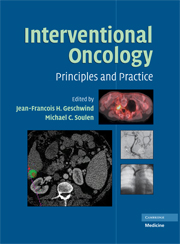Book contents
- Frontmatter
- Contents
- FOREWORD
- ACKNOWLEDGMENTS
- CONTRIBUTORS
- PART I PRINCIPLES OF ONCOLOGY
- PART II PRINCIPLES OF IMAGE-GUIDED THERAPIES
- PART III ORGAN-SPECIFIC CANCERS
- PART IV SPECIALIZED INTERVENTIONAL TECHNIQUES IN CANCER CARE
- 42 Vascular Access: Venous and Arterial Ports
- 43 Gastrointestinal Stenting
- 44 Diagnosis and Management of Superior Vena Cava Syndrome
- 45 Palliative Care and Symptom Management
- 46 Complications of Therapeutic Endovascular Procedures in Malignant Liver Diseases
- INDEX
- Plate section
- References
43 - Gastrointestinal Stenting
from PART IV - SPECIALIZED INTERVENTIONAL TECHNIQUES IN CANCER CARE
Published online by Cambridge University Press: 18 May 2010
- Frontmatter
- Contents
- FOREWORD
- ACKNOWLEDGMENTS
- CONTRIBUTORS
- PART I PRINCIPLES OF ONCOLOGY
- PART II PRINCIPLES OF IMAGE-GUIDED THERAPIES
- PART III ORGAN-SPECIFIC CANCERS
- PART IV SPECIALIZED INTERVENTIONAL TECHNIQUES IN CANCER CARE
- 42 Vascular Access: Venous and Arterial Ports
- 43 Gastrointestinal Stenting
- 44 Diagnosis and Management of Superior Vena Cava Syndrome
- 45 Palliative Care and Symptom Management
- 46 Complications of Therapeutic Endovascular Procedures in Malignant Liver Diseases
- INDEX
- Plate section
- References
Summary
Endoscopic palliation of biliary and luminal obstruction can be achieved with the use of gastrointestinal stents. Although rigid esophageal stents were initially employed for palliation of dysphagia, self-expandable stents (plastic and metal) are almost exclusively used currently. Self-expandable metal stents (SEMS) are used for palliation of malignant gastroduodenal and colonic obstruction and can be deployed as far distally or proximally in the gastrointestinal tract as can be reached with long-length endoscopes passed orally or rectally, respectively. The use of biliary stents for malignant biliary obstruction is discussed in Chapter 31. This chapter will outline the use of stents in the gastrointestinal tract to provide endoluminal palliation.
BASIC PRINCIPLES
SEMS are composed of a variety of metal alloys with varying shapes and sizes depending on the individual manufacturer and organ of placement (1). SEMS are preloaded in a collapsed (constrained) position, mounted on a small-diameter delivery catheter. A central lumen within the delivery system allows for passage over a guidewire. Once the guidewire has been advanced beyond the obstruction, the constrained stent is passed over the guidewire and positioned across the stricture. The constraint system is released or withdrawn, which allows radial expansion of the stent and of the stenosed lumen during deployment. The radial expansile forces and degree of shortening differ between stent types (2). Metal SEMS may also have a covering membrane (covered stents) to prevent tumor ingrowth through the mesh wall and to close fistulas.
- Type
- Chapter
- Information
- Interventional OncologyPrinciples and Practice, pp. 544 - 551Publisher: Cambridge University PressPrint publication year: 2008



